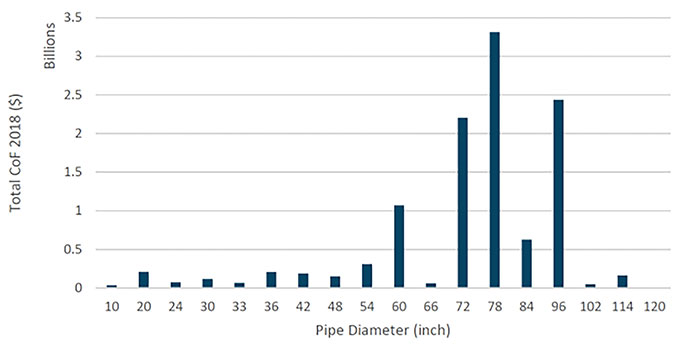September 2018 Vol. 73 No. 9
Rehabilitation
Using Risk to Drive Pipeline Integrity Programs

Jennifer Steffens, P.E. | NASSCO Pressure Pipe Committee
The management of critical infrastructure is a major challenge for water and wastewater utilities as populations increase, available resources decrease, and pipelines need to be maintained, since wholesale replacement of these assets is not practical.
Water and wastewater utility master plans are typically undertaken to identify systematic needs related to demand (water) and capacity (wastewater) using historical data, population projections and hydraulic models as the primary tools. The hydraulic evaluations performed under a master plan typically lead to recommendations for capital improvement projects (CIP). Additionally, master plans provide a general CIP budget for other utility needs, such as aging infrastructure challenges.
However, developing long-term planning strategies for aging infrastructure that does not need hydraulic upgrades is where master plans typically fall short. They are simply not designed to provide a holistic approach to this problem. Therefore, this article proposes going one step further than using age or failures for CIP budgetary planning by no longer using risk as a guide for replacement programs, but instead using risk as a first step in developing a pipeline integrity program.
Defining risk
Risk can be defined as a situation involving the potential of gaining or losing something of value. For a public utility, risk is typically associated with whether the organization meets regulatory, customer and internally established levels of service. Therefore, to develop a holistic approach to managing a public utility’s infrastructure, risk evaluation and management should play a key role in the strategy.
Risk evaluation considers both the probability and consequence of failure, as shown in Figure 1. Probability of failure estimates the likelihood an asset will not meet the defined levels of service. Consequence of failure establishes the social, economic and environmental impacts should an asset fail. The product of the probability and consequence of failure establishes the asset risk.
The example results within this article are from a wholesale water supplier in the U.S. Given the potential impacts, due to the number of customers, pipeline failures have a significant consequence. Previously, a traditional approach to manage deteriorating pipes has been large-scale CIPs to replace the mains. However, this strategy has been shown to be resource-consuming and often ends with the replacement of pipes that still have substantial amounts of remaining useful life.
A more fiscally responsible asset management strategy is the implementation of a pipeline integrity program, which consists of condition assessment and targeted repair of pipelines to mitigate the risk of pipe failure. According to Water Research Foundation Project No. 4451, Managing Infrastructure Risk: The Consequence of Failure for Buried Assets (WRF 2017), the keys to successful risk management are as follows:
- Identify and prioritize risks
- Select risk mitigation approaches
- Implement and maintain risk mitigation approaches
- Conduct performance monitoring and adjust as needed
- Communicate effectively with stakeholders
In a proactive approach, the utility implemented a pipe integrity program with the objective of minimizing both the probability and consequence of pipelines failing. The program included a pipeline risk assessment of the transmission mains to determine which should be assessed first, as well as recommendations on implementation and execution of a condition assessment and renewal program.
Risk framework
The general risk framework was developed using an approach outlined in Pipeline Risk Assessment by Muhlbauer, W.K. (2004). Using data collected during the gap analysis phase of the project, the risk values are quantified as an annualized expected loss in terms of cost given the represented exposure rates, relative resilience and mitigation strategies for each of the analyzed assets.
Once the expected risk losses are determined, the assets can be prioritized from highest to lowest risk, so that appropriate mitigation strategies can be identified and project costs are estimated. Capital and operating budgets are then estimated by optimizing the available budget needed to inspect the assets with high risks.
The results of this process are summarized in Figure 2, showing the failure impact in terms of pipe diameter. As expected, large-diameter pipelines have a higher monetized risk as they carry more fluid and generally provide service to larger areas of the system.

Condition assessment planning
This risk framework and associated advanced analytics can be used to deliver a prioritized list of pipeline assets for condition assessment, which provides various degrees of data resolution to better focus repairs. Addressing problems found through inspections can range from point repairs to replacement. This proactive approach both reduces risk and allows for more efficient and optimized allocation of resources.
Having knowledge of the condition of the pipe ensures that capital expenditures are allocated at the right time and in the right places. Understanding the current condition of the pipe allows immediate action to correct any severe problems. Pipe condition data can also be used to identify the root causes of damage, so steps can be taken to mitigate them and further extend the life of the pipelines. The condition data helps to update risk models and optimize planning by using field results to inform decisions on the future management of the pipeline.
REFERENCES
WRF (2017). Managing Infrastructure Risk: The Consequence of Failure for Buried Assets. Water Research Foundation.
Muhlberger, W. K. (2004). Pipeline Risk Management Manual: Ideas, Techniques, And
Resources. Gulf Professional Publishing.
 About the Author:
About the Author:
Since joining Pure Technologies in 2011, Jennifer Steffens has initiated and managed several projects within the company, including a nationwide research initiative of the cost-saving benefits of an assess and address approach to asset management. Steffens currently serves as wastewater market sector leader and is responsible for all aspects of the company’s wastewater business. She has served as co-chair of NASSCO’s Pressure Pipe Committee for three years.




Comments